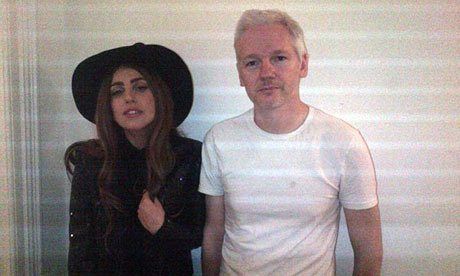
If youÔÇÖre not from England, where Julian Assange has spent five years in LondonÔÇÖs Ecuadorian embassy, you might not be aware that in October 2012 Lady Gaga became one of a long line of celebrities to visit the WikiLeaks founder and de facto political prisoner there. Assange cannot leave the building for fear of extradition to Sweden to face rape charges, and then extradition from Sweden to the U.S. for a possible espionage trial. Plenty of celebrities, though, have come to him, including fashion designer Vivienne Westwood, Yoko Ono and Sean Lennon, Maggie Gyllenhaal and Peter Sarsgaard, John Cusack, and Pamela Anderson. GagaÔÇÖs well-documented visit, indeed, was at the behest of rapper M.I.A., whoÔÇÖd tweeted to Gaga, ÔÇ£im there. ill bring TEA and CAKE,ÔÇØ but itÔÇÖs still a shock to see her pop up in AssangeÔÇÖs Spartan room, in a black witchÔÇÖs outfit, two-thirds of the way through Laura PoitrasÔÇÖs new documentary Risk, which debuted at Cannes this week.
Poitras had started Risk when Assange was still a free man, and put it on hold to focus on her Oscar-winning Citizenfour ÔÇö and even the odd 10-chapter structure canÔÇÖt hide the quite obvious missing years in between. From the start weÔÇÖre given the sense that we will emerge with intimate knowledge of this man who so often comes across as a figurehead in love with his own myth. The opening shot is a promising close-up of Assange in a mirror, his hair dyed red, an uncharacteristic goatee on his face, putting in colored contact lenses. His vulnerability shows that a life of constantly having to put on disguises or go into hiding may be no life at all.
We see Assange engage in high-wire semantics on the phone with a State Department lawyer before leaking un-redacted cables, aware that any whiff of anti-U.S. sentiment will be gathered as evidence of his ÔÇ£intentÔÇØ under the Espionage Act. Not a single phone call goes by that Assange does not record. WeÔÇÖre in the room as Assange finds out about the arrest of soldier Bradley (now Chelsea) Manning for leaking three-quarters of a million classified or sensitive military and diplomatic documents to WikiLeaks. (Manning is now serving 35 years in federal prison.) We hear from Assange about the philosophy that drives him: ÔÇ£Every day you go through life, you lose a day of life. So if youÔÇÖre not fighting for the things you care about, youÔÇÖre losing.ÔÇØ We watch him get a haircut from WikiLeaks technology officer Jacob Applebaum (the real charismatic center of the film) because thereÔÇÖs no one else Assange trusts to cut his hair. And we see his ebullient reaction when heÔÇÖs granted asylum.
After the screening, Poitras was joined onstage by Applebaum (whoÔÇÖs now living in ÔÇ£free EuropeÔÇØ on advice of lawyers), and WikiLeaks publisher Sarah Harrison, who was at one time AssangeÔÇÖs girlfriend, and is also prominent in the film. Harrison also famously accompanied Edward Snowden on his flight from Hong Kong to political asylum in Moscow. They read aloud a statement that decried what they called his illegal detention by the U.K. and Sweden, which was condemned by the United Nations this February, and called for his release: ÔÇ£May 28th will mark the 2000th day of his unlawful deprivation of liberty. His illegal detention and political persecution must end. For more information, read Justice4Assange.com. Free Julian.ÔÇØ Applebaum also threw in a dig to ÔÇ£mainstream mediaÔÇØ for demonizing Assange and not pressuring the Britain and Sweden to adhere to the U.N.ÔÇÖs finding. ÔÇ£In the U.S.,ÔÇØ he said, ÔÇ£most of the journalists are propagandists and stenographers for the State.ÔÇØ
All three people onstage clearly cared deeply about the man. So why does Assange still seem so distant and unknowable at the end of the film? Poitras is a brave and important filmmaker ÔÇö one whose work has put her in the room for important moments in history, and on a terrorist watch list since 2006, after making My Country, My Country about the Iraq War. But she either doesnÔÇÖt know how to tell a story, or doesnÔÇÖt care. The unparalleled access she gets with subjects like Assange and Snowden seems to be in part because they know she is sympathetic to their cause, with the result being that she makes films about people who question the government and the status quo without ever seeming to pose tough questions to her subjects themselves. She presumes her audienceÔÇÖs interest, and presents her footage as if that access is enough.

Lady GagaÔÇÖs visit may seem like a light bit of comic relief among all heady government secrets and imminent arrest, but itÔÇÖs actually the most illuminating moment of the film. For a few brief minutes, she pulls out her own camera, while being filmed by PoitrasÔÇÖs, and gives Assange the fresh and honest grilling weÔÇÖve been missing.
ÔÇ£This is your room?!ÔÇØ she asks, aghast. She then instructs him to change out of his suit and ÔÇ£put on a dirty fucking T-shirt,ÔÇØ before she starts filming, ÔÇ£like a rebel.ÔÇØ Suitably punked-up, he sits down as she asks him probing questions like, ÔÇ£WhatÔÇÖs your favorite food?ÔÇØ
ÔÇ£LetÔÇÖs not pretend for a moment IÔÇÖm a normal person,ÔÇØ Assange replies, laughing.
When he runs down the long list of agencies that are after him, Gaga, seemingly bored, summarizes: ÔÇ£A lot of fucking people.ÔÇØ
ÔÇ£Do you ever feel like just fucking crying, even when youÔÇÖre happy?ÔÇØ she wants to know. No, self-pity is useless (ÔÇ£why does it matter what I feel?ÔÇØ). And ÔÇ£Do you love your mom?ÔÇØ He does. ÔÇ£What about your dad?ÔÇØ
ÔÇ£My dad is much more complex,ÔÇØ says Assange.
ÔÇ£So, nothing like you,ÔÇØ says Gaga.
A few moments later, sheÔÇÖs gone, and weÔÇÖre back to PoitrasÔÇÖs all-access, no-questions world. How different the film might have been if sheÔÇÖd kept Gaga on as a consultant. Then maybe weÔÇÖd get to see AssangeÔÇÖs ugly, his disease, his everything.

